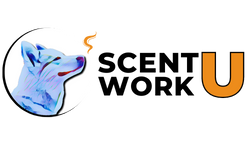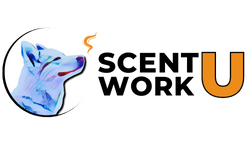What Are You Teaching, Really?

Every time we interact with our dogs, we are teaching them something. This is true in day-to-day life but also in Scent Work. However, this simple fact is oftentimes lost when we are tackling new, “snazzy” or “sexy” searches. Suddenly, problems begin popping up all over the place and we do not know why! Could it be that we were so focused on doing something more “advanced” that we forgot to consider what we were ACTUALLY teaching the dog to do
MINDFUL TRAINING IS A MUST
Anyone who has worked with me has heard this spiel before: we must be mindful and thoughtful when we are working with our dogs, especially when it comes to Scent Work.
We must remember that we are working with an alien species that perceives the world quite differently than we do. To make matters even more complicated, they are essentially guessing what we want at every turn, as if they were playing a never-ending game of charades. If we are not clear, it is exceedingly likely, and even expected, that their guess is going to be WAY off from what we truly wanted them to do.
Let’s take working with distractors as an example. A very common approach in all sorts of dog training is to simply have a variety of distractors in the space and reward the dog when they do the task that was asked of them.
“Yes, that is how you work on distractors…what’s your point?”
Notice I didn’t mention HOW the distractors are arranged in the space. Or how the overall exercise was designed. Or whether the expectation for the dog was adjusted since we added these distractors, essentially drastically training the entirety of the training picture.
“I still don’t get it. If you are working on distractors, you add distractors. It is that simple.”
We're missing each other...no worries, I’ll give you an example. You are working on recalls. After a few training sessions of getting your dog to consistently come to you with no distractors present, you now have a bowl of food, their favorite toy and a human assistant in the space, all located in between you and the dog.
“That sounds great!”
You call your dog, they eat some of the food from the bowl, investigate their toy, say “Hi” to the assistant and then come to you. What do you do?
“Well, they came to me.”
Right! I would sincerely hope that you rewarded them for coming to you!
“Alright…now I am totally confused. I thought you were trying to imply this set-up was bad in some way.”
It is.
“UGH!”
Don’t stress grasshopper. Break this down. What was our ultimate goal with this recall exercise? To get the dog to come to us. What did the dog do? They ate the food, played with their toy, visited with the stranger and THEN came to us. I doubt when you are frantically and hysterically calling your dog who slipped out the front door chasing the squirrel you want them doing a million different things BEFORE they come to you.
“Oh…”
See? It is not that practicing with distractors in and of itself is BAD, it is HOW we do it that matters. Put simply, you need to ask yourself, “What am I TEACHING the dog with this set-up?”
“So, what would be a better way of doing the recall thing?”
Glad you asked! Have the distractors so low-level and out-of-play the dog doesn’t even consider them as distractors at first.
“That’s dumb! A distractor is supposed to DISTRACT the dog!”
Have you ever heard of practice makes perfect?
“Yes…”
This also applies to dog training. If your dog has multiple instances of doing what you DON’T want them to do, in this case messing with the distractors BEFORE they come to you, they will get BETTER at doing that!
“Oh….”
Yeah. Is this starting to ring any bells in how you may be working with distractors in Scent Work?
“A little bit…”
You are not alone! A SUPER common approach is to simply have a ton of distractors out and about within a search area, almost ENCOURAGING the dog to mess with them FIRST and then maybe, eventually, if they feel like it, go find their hide.
The rewarded behavior sequence becomes: be invested in the environment, mess with, or even be rewarded by distractors, and eventually find your hide then receive a reward.
It is also entirely possible your dog determines going for the distractor is MORE reinforcing than finding their hide! YIKES! All this time you have spent training in Scent Work and it is undone in a few short sessions.
“Ms. Trainer Lady, you are depressing me.”
I’m sorry grasshopper, I truly am, but it is important to talk about these things.
Before you run your dog in ANY search, stop and ask yourself: what am I trying to teach in this moment? What will my dog actually learn in this search? How will they approach this? What do I expect them to do? Is it FAIR for me to expect that of them given the level of training they have right now?
“I’m not sure how to do all of this…”
Let me give you another example to try to help this make more sense. Dogs who offer aggressive alerts, by either pawing or mouthing at a hide. This behavior does not come out of nowhere. It is TAUGHT as something that is expected of the dog, something that is REWARDED. A common reason is the delay in rewarding the dog for a job well done, so the dog takes it up a notch. Simply finding the hide wasn’t enough, perhaps clawing at it will earn them their goodie. Sure enough, they claw at the hide and cookies fall from the heavens. Lesson learned.
“Oy…”
Yet another example is a dog who is cueing off the handler. This can be taught in a variety of ways, but most commonly is when you step in to “save” the dog. Dogs are smart. They learn that YOU are the one that will ultimately find their cookie opportunity. For all they know, that is the game! They go around, sniff for a bit, you step in, point out the hide and they get a cookie. Fun!
“I am so depressed now.”
Please don’t fret. All of this is SUPER common and understandable. Doing Scent Work and working on increasingly challenging searches is alluring and exciting! However, we need to ensure each step of the way, the dog really does have an understanding of what the game is truly all about. This means WE must understand what our goals are for this activity.
Blindly slapping hides around mindlessly is only going to get you so far. Eventually the miscommunication or misunderstanding of what the rules or expectations of the game are will come back to bite you.
Instead, take a step back and breathe. Gaze upon your training sessions as opportunities to communicate an intent to your dog. Try to be as clear as you possibly can. Think of how THEY may perceive it and then adjust what you are doing from there.
Want to stress upon the dog that all they need to do is FIND the hide, not do a big song and dance that results in aggressive alerts? Pair the hide or get in there SUPER quick to reward them. Do this over an extended period of time to TEACH this new understanding that aggressive alerts are NOT expected and do NOT pay. Then, incrementally, increase the amount of the time until you reward, again, keeping this reasonable.
Looking for the dog to NOT cue off you so much or expect you to “save the day”? Two things will help: design searches you KNOW your dog can do and step back and allow them to do so. Breathe and wait. It can be SO hard to do, but if you work incrementally and are certain your dog can do this search, let them. Breathe and watch. The second they find the hide, come alive and go jackpot them with 3-5 treats fed one right after another, telling them how awesome they were. This gift of allowing the dog to understand THEY can do this and YOU will support them is the best thing you can do. It can be incredibly hard to do, especially if your dog is taking, 1, 2, 5, 10 minutes to find their hide. Those minutes feel like an eternity at the time! But if your dog is WORKING and not stressing out, let them do this learning. It is so powerful and will allow them to be MORE successful next time.
FINAL THOUGHTS
Mindful training absolutely takes more effort, there is no denying it. But the results speak for themselves. Dogs have a clearer understanding of what is expected of them, and handlers are less likely to become frustrated, flustered or flabbergasted since they were observant, careful, and mindful in the first place.
In my opinion, mindful training is what makes training fun. Identifying what my teaching objectives are. Objectively assessing where my dog is right now in their training and understanding and where we need to go from here. Figuring out how I can ensure I am setting up the searches to teach the skills I am looking for and avoid common misunderstandings or pitfalls. If this means stretching out a given learning objective across 20 different training sessions to achieve my goal in a clean fashion, where the dog is successful every time and is clear on what we are doing, I am happy to do so. That is the EXCITING part of training for me. Not that the dog can find the hide. It is how I can decode a human process into something the dog truly understands and stretch MYSELF to meet THEIR needs. That is the fun part.
Want to give this mindful training business a try? Make a list of what your learning objectives are for Scent Work. Start off simple and make it more involved as you become more comfortable with the process. Some examples may include:
- Dog finds the hide.
- Dog works independently without looking to the handler or asking questions.
- Dog works confidently throughout the entire search.
- Dog focuses on the hide and doesn’t get sucked into the environment or tripped up by distractors.
- Dog is tenacious in solving all their odor puzzles.
- Handler allows the dog to take the lead.
- Handler proficiently handles their leash or long line.
- Handler properly supports the dog without interfering.

Dianna has been training dogs professionally since 2011. She has done everything from teaching group training classes and private lessons, to specializing in working with fearful, reactive and aggressive dogs, to being a trial official and competition organization staff member.
Following a serious neck and back injury, Dianna was forced to retire from in-person dog training. But she was not ready to give up her passion! So, she created Pet Dog U and Scent Work University to provide outstanding online dog training to as many dog handlers, owners and trainers possible…regardless of where they live! Dianna is incredibly grateful to the amazingly talented group of instructors who have joined PDU and SWU and she looks forward to the continued growth of PDU and SWU and increased learning opportunities all of these online dog training platforms can provide.
In June 2021, Dianna and her business partner, Sean McMurray launched Cyber Scent Work, Inc., an organization that operates in the gray space between training and trialing in Scent Work. With Cyber Scent Work, Inc., handlers have the opportunity to earn Qs, titles and ribbons while also receiving helpful training advice regardless of whether they qualify or not! Be sure to check out Cyber Scent Work, Inc., you will be happy you did!
Join Our Newsletter
Stay up to date with all the happenings at Scent Work University, including the release of new online courses, seminars, webinars, eBooks and receive exclusive promotions and discounts!


